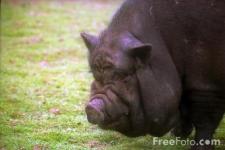The Problem With Super-Muscly Pigs
By Judith Benz-Schwarzburg & Arianna Ferrari,
Slate
| 06. 03. 2016
Animal research is moving rapidly in two divergent directions.
Research on animal cognition, behavior, and welfare is teaching us that many animal species have complex cognitive and emotional lives and needs, which are linked to the way they experience and explore their surroundings. For instance, pigs are quite advanced: They have long-term memory and are sensitive to the emotions of other pigs. They can also use mirrors to locate food behind barriers and can determine whether humans are paying attention to them by looking at people’s heads. There lies a danger in underestimating such capabilities: If animals live in a very restricted environment without any cognitive or social challenges, preventing them from expressing species-typical behavior, they can experience welfare problems. Research insight into animal cognition is giving us—or should be giving us—increased empathy for other species and better recognition of their needs.
At the same time, new gene-editing technologies are allowing scientists to design animals in ways that maximize their economic value as food sources. These technologies permit the direct manipulation of virtually any gene of a living organism...
Related Articles
By Emily Glazer, Katherine Long, Amy Dockser Marcus, The Wall Street Journal | 11.08.2025
For months, a small company in San Francisco has been pursuing a secretive project: the birth of a genetically engineered baby.
Backed by OpenAI chief executive Sam Altman and his husband, along with Coinbase co-founder and CEO Brian Armstrong, the startup—called...
By Jessica Hamzelou, MIT Technology Review | 11.07.2025
This week, we heard that Tom Brady had his dog cloned. The former quarterback revealed that his Junie is actually a clone of Lua, a pit bull mix that died in 2023.
Brady’s announcement follows those of celebrities like Paris...
By Emily Mullin, Wired | 10.30.2025
In 2018, Chinese scientist He Jiankui shocked the world when he revealed that he had created the first gene-edited babies. Using Crispr, he tweaked the genes of three human embryos in an attempt to make them immune to HIV and...
Public domain portrait of James D. Watson by Cold Spring Harbor Laboratory
and the National Human Genome Research Institute on Wikimedia Commons
James Watson, a scientist famous for ground-breaking work on DNA and notorious for expressing his antediluvian opinions, died on November 6, at the age of 97. Watson’s scientific eminence was primarily based on the 1953 discovery of the helical structure of DNA, for which he, Francis Crick and Maurice Wilkins shared the 1962 Nobel Prize in Physiology or...




